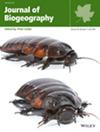In Situ Speciation of Dispersal-Limited Taxa Leads to Strong Phylogenetic Community Clustering
Abstract
Aim
Phylogenetic community structures have traditionally been interpreted through the lens of niche processes, such as environmental filtering and interspecific competition. However, these structures have been continuously shaped over evolutionary time by biogeographical dynamics, a process that is often overlooked. Here, we disentangled the influence of speciation and dispersal on spatial phylogenetic structures using neutral simulation models, while turning off niche-based processes.
Location
South America.
Taxon
Simulated clades.
Methods
We simulated biogeographical dynamics of individuals evolving under random speciation, dispersal and demographic processes. Each model incorporated different combinations of speciation and dispersal rates, and the phylogenetic structures of its communities were assessed using standardised effect sizes of Mean Phylogenetic Distances (SESMPD). We evaluated the SESMPD in response to varying degrees of speciation and dispersal rates, and its relationship with community isolation, using Ordinary Least Square (OLS) models.
Results
Increased speciation rates and reduced rates both contribute to higher phylogenetic clustering, leading to a higher co-occurrence of closely related species. While both variables independently influence phylogenetic structure, the extent of phylogenetic clustering is primarily determined by the increased ratio between speciation and dispersal rates. This trend toward phylogenetic clustering persisted even at smaller scales, albeit with reduced intensity. Clustering was more pronounced in isolated communities, with the effects intensifying based on the combination of speciation and dispersal rates.
Main Conclusions
Our study demonstrates that biogeographical dynamics can drive strong phylogenetic structures even in the absence of niche processes. Specifically, in situ speciation rates can enhance phylogenetic clustering by continuously adding species to community pools, such as through the exploitation of novel ecological opportunities. However, the extent of this clustering largely depends on the degree of geographical isolation and dispersal limitations experienced by the radiating lineages, which influence biotic interchange and phylogenetic homogenisation among community compositions.

 求助内容:
求助内容: 应助结果提醒方式:
应助结果提醒方式:


